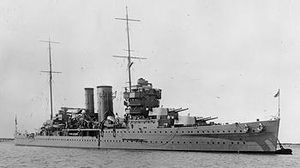- HMS York (90)
-
HMS York (90) 
HMS York (90)Banderas 
Historial Astillero Palmers Shipbuilding and Iron Company, Jarrow Clase clase York Tipo Crucero pesado Autorizado 31 de octubre de 1926 Iniciado 16 de mayo de 1927 Botado 17 de julio de 1928 Asignado 1 de mayo de 1930 Baja 26 de marzo de 1941 Destino hundido, desguazado en 1952 Características generales Desplazamiento 10.400 t. estándar. Eslora 164.5 m Manga 17,6 m Calado 6,1 m Blindaje • cinturón blindado: 51-76 mm
• cubiertas: 51 mm
• barbetas: 38-51 mmArmamento • 6 cañones en montaje doble Mk II (L/50) de 203 mm.
• 16 cañones en montaje simple Mk V (L/25) de 102 mm.
• 6 tubos torpederos de 533 mm.
• 8 cañones Mk III de 12,7 mm en montajes cuadrúples (L/50).Propulsión • 8 calderas Admiralty
• 4 turbinas Parsons
• 4 hélicesPotencia 80.000 cv Velocidad 32 nudos Tripulación 630 hombres Aeronaves 1 Fairey Seafox Equipamiento aeronaves catapulta rotatoria HMS York (90) Fue un crucero pesado de la Real Marina Británica perteneciente y cabeza de serie de la clase York junto al HMS Exeter (68). Participó extensamente entre la preguerra y brevemente en los periodos iniciales de la Segunda Guerra Mundial.
El HMS York mostraba un puente tipo County y sus chimeneas eran levemente lanzadas hacía popa. Al igual que su cuasi-gemelo, el HMS Exeter, adolecía de deficiencias de blindaje y de tránsito expedito en cubierta debido a su masivas instalaciones en la cubierta principal.
Contenido
Historia
El HMS York desde su alta en 1930 estuvo asignado a la 8ª fuerza naval que hizo representaciones en Sudamérica y en las Indias Orientales del mismo modo que su cuasi-gemelo. Estuvo además en el Mediterráneo y en Canadá hasta 1939.
En 1940 se le asignó al 3er. escuadrón de cruceros en el Mediterráneo y tuvo participación en el intento de captura del buque de pasajeros alemán Arucas fuera de Islandia, siendo este último hundido por su propia tripulación y rescatados los supervivientes por el crucero británico.
Participó en la Campaña de Noruega evacuando tropas francesas e inglesas junto al HMS Devonshire y protección de convoyes por el Mediterráneo. Precisamente, estando en estos deberes participó junto al HMS Ajax en el combate naval de Cabo Passero en octubre de 1940 combatiendo a la 11ª. flotilla de destructores italianos y hundiendo al destructor Artigliere.
Final
El 26 de marzo de 1941, estando en Creta, concretamente en la Bahía de Suda fue atacado por dos lanchas torpederas italianas; el resultado del ataque fue la total inundación de la sala de calderas, hundiéndose hasta la superestructura (obra muerta) en aguas someras. Se pensó en rescatarlo, pero la ayuda enviada ( un submarino, el HMS Rover) no pudo llegar a destino y se decidió inutilizar el crucero con cargas de demolición el 22 de mayo de ese mismo año, no sin antes desmontar las piezas artilleras y dejarlas para la defensa de la isla. En 1952, el casco fue removido del lugar y remolcado a la isla de Bari para su total desarme.
Bibliografía
- Armamento y poder militar (Tomo 6). Madrid, España: Sarpe. 1983. ISBN 978-84-7291-680-7.
Enlaces externos
Categorías:- Clase York
- Buques de guerra de los años 1920
Wikimedia foundation. 2010.
